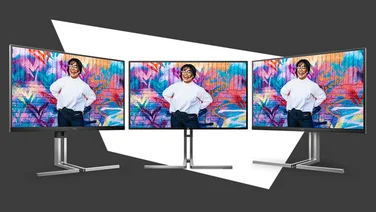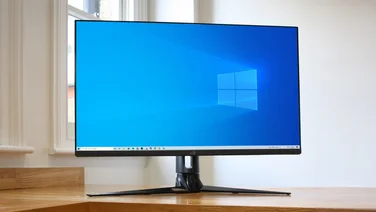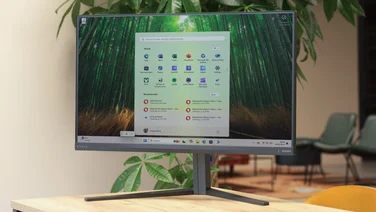To help us provide you with free impartial advice, we may earn a commission if you buy through links on our site. Learn more

















- 144Hz refresh rate at 1440p
- Ideal for competitive and casual gamers
- Punchy colours
- GameSense doesn’t support all games
- Too dim when 'Fastest' response time setting enabled
Keyboards, mice and headsets, even speakers – every gaming peripheral, it seems, comes with an option for RGB lighting these days and now MSI has decided it’s time to light up another part of your build. The company’s Optix MPG27CQ monitor comes with fully customisable RGB lighting along the bottom edge and around the back, too.
It’s not just static lighting, though: the MSI MPG27CQ is the first monitor to integrate SteelSeries’ GameSense technology. This works with some popular games (CS:GO, Minecraft and DOTA 2) to indicate certain in-game information via your RGB hardware, so you can see how low your ammo is or track your health.
READ NEXT: Best gaming monitors
MSI Optix MPG27CQ review: What you need to know
Other than fully customisable RGB lights, the MSI Optix MPG27CQ is also a serious gaming monitor. It has a curved 27in VA panel with a resolution of 1440p and a refresh rate of 144Hz. MSI claims it has a 1ms response time and, if that wasn’t enough, it supports AMD’s FreeSync technology. The panel is borderless on three sides and the whole thing is beautifully built.

















READ NEXT: Asus ROG Strix XG32VQ review: The fanciest big-screen gaming monitor in town
MSI Optix MPG27CQ review: Price and competition
The price you have to pay for all those glorious features? A handsome £519. If you shop around, you can find it for around £502; either way, though, it’s expensive.
At this price, two competitors spring to mind. First, the Samsung C27HG70, which is the same size but comes with an HDR Quantum Dot panel instead. Second, the Asus ROG Strix Curved XG32VQ, which is larger but, uses a curved 32in VA panel and also has RGB lighting.
If you’re not fussed about RGB lighting, HDR or a curved screen, then the Acer XF270HUA is a good choice. The Acer, which is the best gaming monitor on the market, is currently available at a tempting price of £338.
READ NEXT: Acer XF270HUA review: The best gaming monitor on the market
MSI Optix MPG27CQ review: Design, features and build quality
The MPG27CQ’s design and build quality are superb. I love the placement of the RGB lights, which are located in a strip along the bottom edge of the monitor, and on a diagonal axis across the back. What’s most impressive about these, though, is the level of customisation available on offer.
The strip of LEDs at the front is split into five groups at the front, each of which comprises eight LEDs and there are 23 LEDs at the back, too. All of these can be customised through SteelSeries’ Engine 3 software and changes you make to the lights are applied in real-time when you have Live Preview enabled.

















All these lights and the GameSense software make a potent combination, enabling you to set LEDs to indicate your in-game health, ammo or even the number of kills you’ve got per round. Not interested in that? Well, you can still use the RGB lights to visualise your songs, and you can even synchronise the lights with on-screen visuals. Of course, if you want some peace and quiet, you can disable the lights through SteelSeries’ software or manually disable it through the OSD.

















Aside from the lighting system, MSI has spent some considerable time on the overall design of the monitor. The MPG27CQ has an 1800R curvature, which adds an extra layer of immersion. The monitor’s three-side borderless design also means you’re a little less distracted by large black bezels around the screen and if you’ve the means to buy two or three, they sit neatly together with exceedingly narrow borders between them.

















The MPG27CQ’s stand provides a sturdy base but it’s big at 612mm wide and 379mm deep and its triangular shape is a little on the awkward side. It’s definitely worth measuring your desk to ensure it’s big enough. As for adjustments, the stand can swivel by 40° to the left and right, tilt in the range of +20° to -5° and has a height adjustment range of 120mm. Alternatively, you can mount the monitor on a compatible 100 x 100mm VESA stand.

















For connectivity, you get DisplayPort 1.2 and two HDMI 2.0 inputs and in order for GameSense to work, you’ll also need to plug in a USB cable. This also enables two additional downstream USB 3.0 ports on the left edge of the monitor, which next to a pair of 3.5mm headphone and mic jacks.

















To access the OSD, there’s a handy joystick around the back right-hand side of the monitor. The OSD itself is laid out perfectly and along the top of the menus there’s a row that shows what resolution, refresh rate, game mode, and the input the monitor is running and if it has Zero Latency enabled (more on which below). If you ever get fed up of reaching out and fiddling with the monitor controls, there’s also MSI’s Gaming OSD software, which allows you, via the USB cable again, to change settings via a Windows application.
READ NEXT: Best gaming headset – our pick of the best
MSI Optix MPG27CQ review: Image quality
The MPG27CQ has a curved 27in 2,560 x 1,440 VA panel that runs at 144Hz. Quality is decent: colours pop nicely, the contrast ratio is an excellent 2,602:1 and out of the box the panel’s total colour gamut coverage sits somewhere in between the DCI-P3 and sRGB colour space.

















It gets bright, too. Peak luminance sits at 385cd/m², which is ideal if you’re using it in a bright, sunlit room. As for the monitor’s brightness uniformity, there’s only a 10% deviation from the centre-point, which is an exceptional performance for a gaming monitor.
If you want the fastest response time from the monitor, however, you’ll have to put up with lower brightness. With the “Fastest” response time setting selected in the OSD, peak brightness falls to 192cd/m².
Colour accuracy isn’t the best, either, with an average Delta E measurement of 2.74 (lower is better) and a maximum of 6.8. By comparison, the Samsung C27HG70 is more colour accurate at a measured 1.98 and 4.42, respectively. The MPG27CQ looks a touch washed out, too.
READ NEXT: AOC AGON AG352UCG review: The perfect monitor for casual gamers, but at a price
MSI Optix MPG27CQ review: Gaming performance
The MPG27CQ might not have the most colour accurate panel on the market but its gaming capabilities are better. Its 1440p resolution is a big step up for anyone coming from Full HD and the 144Hz refresh rate also means you’ll enjoy buttery smooth frame rates, assuming your graphics card is up to the task.
The monitor’s response time is good, too. Set to the “Fastest” response time setting the monitor runs extremely well. However, there are a few caveats. In this mode the panel suffers from overshoot ghosting, is limited to a maximum brightness of 192cd/m², and you can’t enable the monitor’s “Zero Latency” mode, to keep input lag to a minimum. I’d suggest using the monitor on the ‘Fast’ setting. Here, you’ll get minimal overshoot and, yet, won’t have to compromise too much on the monitor’s responsiveness.

















With these settings engaged the monitor is perfectly competent for competitive gaming and with “Zero Latency” enabled, perceived input lag is minimal. It’s a great monitor for playing Counter-Strike: Global Offensive (CS:GO), PUBG, and Overwatch on.
Last, but by no means least, the monitor supports AMD FreeSync at a range of 48Hz-144Hz, which means those with a compatible AMD graphics card can enjoy tear-free gaming. If you have an Nvidia graphics card, you can reduce tearing with V-Sync, but that adds a lot of unwanted input lag.
READ NEXT: Samsung CHG70 review (C27HG70): The world’s first HDR gaming monitor
MSI Optix MPG27CQ review: Verdict
The MSI Optix MPG27CQ is a fantastic monitor that deserves plenty of praise. It has impressive build quality, looks great, gaming performance is good and image quality is excellent. And I do like the was MSI has implemented its RGB lighting system, serving a purpose beyond pure ostentation.
However, this feature comes at a price. At £520, the MPG27CQ isn’t cheap, especially when you consider the similarly priced Samsung C27HG70, which has a more colour-accurate HDR Quantum Dot panel, the Asus ROG Strix Curved XG32VQ, which is larger, or the ridiculously good Acer XF270HUA, which at the time of writing is just £338.
Despite the MSI representing the best use of RGB I’ve seen on a monitor, then, it’s still not something that would persuade me to choose it over its rivals.







